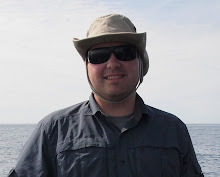It took 2 days driving from the capital of Zambia - Lusaka, but we
arrived at South Luangwa National Park to an amazing sunset. Our
campground overlooked the river that divides the national park from
the Game Management Area. We were camping on the GMA side. The roads
into the park are very bad, so much so that our truck got a flat on
the way (see post "Have and Have Not"). The roads are dirt and rock
with potholes. It takes about 3hrs from the nearest paved road via the
dirt road to reach the park. On this road it was very rural, more so
than I had seen before. Many small villages with no ammenities like
electric, running water, phones, and animals pulling carts on rough
roads - although I did see a thatched roof hut with a satellite dish
on it which was interesting.
Camping in the park was a real pleasure as there was electricity and
running hot/cold water, the grounds were grass, and the main lodge had
a pool and bar. The river had a large hippo population. One could
easily see them from the campground, and they were very noisy. In
fact, one came into our campsite around 3am to graze. It was probably
leas than 10' away from where we were sleeping in a tent! Camping is
good on this trip as it extends our range; there isn't always a hotel
to stay in at some of the key locations (like this one).
Our first full day was spent doing a morning and a night game drive.
Julia and I were lucky to have had some great game drives in Chobe,
Botswana - and the South Luangwa drives were icing on the cake. We
missed seeing cats in Chobe, but were able to see a pride of Lions
resting during the day and 3 Leopards during the night drives. It
really was an incredible experience to see these elusive animals in
their natural habitat, especially the Leopards at night. We also took
a walking safari through the bush with a guide and an armed escort
where we tracked a tower of Giraffe.
In addition, a few of us from the camp got a chance to see the World
Cup final (Spain v Nederlands). We had to hire a car to take us to
another lodge about 30 minutes away that had TV, Cable, and
electricity. The vehicle was an open safari truck and they charged $5/
pp for a round trip. We arrived in time to see the 2nd half (things
move slow in Africa). The bar was crowded with people from all over.
We all crowded around a 19" TV to watch. Memorable.
On our final day in South Luangwa, we visited a local village with
hopes of playing soccer with the locals. Our guide Chris was able to
get us an invitation to the remote village and helped break the ice
once we got there. These people were remote and poor, probably
farmers. The village was primitive by western standards, but clean and
liveable. I don't think they see white people very often (their word
for us is "Mozunga"). Some kids may never have seen white people
before. They would stare at us and giggle sometimes, other times
touching our skin. I responded with being friendly and smiling,
shaking their hands. The kids especially loved Julia's hair. They
looked on with amazement when she would take it down and they would
all want to touch it.
We got our soccer game organized eventually. It was 8 on 8 - on a
small dirt field with wooden tree branch goals (no nets) and a well
worn, slightly deflated soccer ball. There was no referee, just a
timekeeper, so we all just agreed on the calls. The Zambians played
barefoot, while the 3 "Mozunga" (plus our guide Chris who is Zambian)
played with shoes. It was the greatest 45 minutes of soccer I've ever
played. I had a few good touches and a memorable header. Our friend
John scored a goal. We had quite a crowd watching, maybe the whole
village. They would cheer and sing songs during play. When someone
would score a goal people would cheer, sing, and kids would rush out
onto the field doing cartwheels. It was amazing! At the end of the
match, I was filthy from the dust. I'm still coughing up dirt, but it
was well worth it. We were impressed with how well they played, given
that they have so little to play with. They are really good soccer
players! John and Edwina had a brand new soccer ball on the truck that
they bought for themselves, but decided to give it to the village as a
gift. The soccer coach of the village gathered everyone around and
announced that the "Mozunga" gave the village a new ball, and everyone
cheered! They put on a dance for us while we had our guide Chris give
kids some trinkets and pens/paper we had (we made him deal with the
free-for-all; see post "Have and Have Not"). I really can't imagine a
better cultural experience. I think we made a positive impression on
the people of that village; provided some entertainment; and showed we
cared. We were glowing about it for the rest of the day and will
remember it for the rest of our lives as a great moment.
Next stop: Malawi
Note: Most places we stayed in Zambia have been surprised to see us
(Americans). They say not too many Americans come through. Makes us
feel like pioneers of sort.








